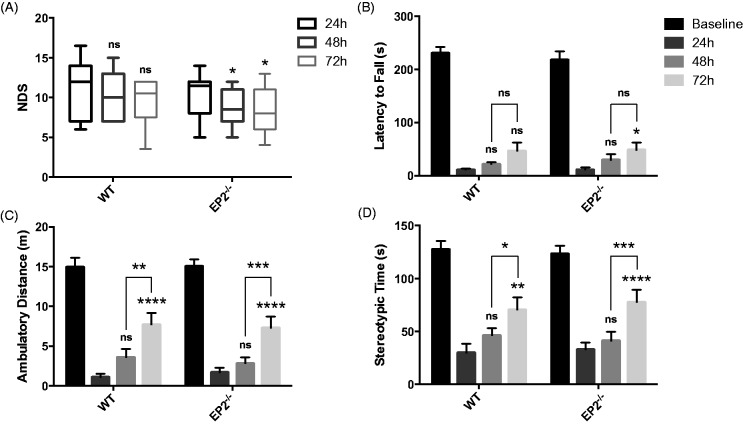Figure 2.
Effect of PGE2 EP2 receptor deletion on functional outcomes after ICH. Neurobehavioral testing of WT and EP2−/− mice was performed by investigators blinded to genotype at 24, 48, and 72 hr following ICH. (a) At 48 and 72 hr after ICH, EP2−/− mice had significantly less neurological deficits when compared with 24 hr, whereas no such recovery was seen for the WT mice. (b) WT and EP2−/− mice had similar baseline rotarod performance. At 24, 48, and 72 hr after ICH, both groups had significantly reduced latency to fall when compared with baseline function (p < .0001). At 72 hr after ICH, EP2−/− mice had improved accelerating rotarod performance when compared with 24 hr, whereas this comparison was not significant for the WT mice. (c and d) No differences in baseline open field locomotor activity were seen for the WT and EP2−/− mice. Both groups had significantly impaired (c) ambulatory distance and (d) stereotypic time at 24, 48, and 72 hr post-ICH when compared with baseline function (p < .0001). WT and EP2−/− mice displayed similar open field locomotor activity, where significant improvements in (c) ambulatory distance and (d) stereotypic time were seen between 48 and 72 hr post-ICH, but not within the 24- to 48-hr period. All comparisons included n = 7 WT and n = 11 EP2−/− mice, and statistics were calculated using a two-way repeated measures analysis of variance with Newman–Keuls multiple comparisons test. Brackets outline 48 to 72 hr comparisons and results above bars are with respect to 24 hr function. ns = not significant, *p < .05. **p < .01. ***p < .001. ****p < .0001. PGE2 = prostaglandin E2; EP2 = E prostanoid receptor subtype 2; ICH = intracerebral hemorrhage; WT = wildtype.

